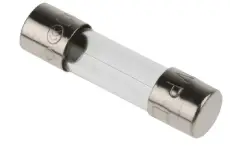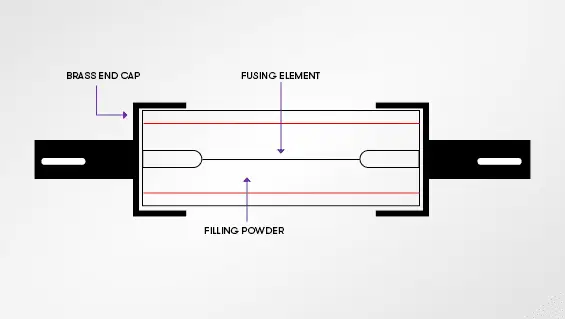

What is a Fuse?
Catalog
What’s the Difference Between a Fuse and a Circuit Breaker?What is a Fuse Box?Fuses in PanasonicFrequently Ask QuestionsRelated ArticlesFuses are simple safety devices that are commonly used in electrical circuits to protect against excess current or overcurrent. If a current stronger than expected flows through, the fuse will blow, cutting the circuit and preventing heat damage. This also lowers the risk of fire or electrocution. This process is called tripping a circuit. The point at which a fuse blows is known as its breaking capacity. Once the fuse has blown, it stops the current and becomes an open fuse.

Fuse
Overcurrent can be caused by things like short circuits (when the current takes an incorrect path), wiring faults, electrical arcs, and similar issues. The heat generated from this can be strong enough to melt the insulation on cables.
What’s the Difference Between a Fuse and a Circuit Breaker?
Fuses and circuit breakers both serve a similar role – they cut off electrical circuits during a current surge or short circuit. But there’s one key difference: Circuit breakers are switches, so they can be reset after being tripped. Fuses, on the other hand, are typically single-use. Once they blow, they need to be replaced. This makes them a weak link, which is actually part of the design.
Fuses are cheap and easy to replace, which means you can quickly get things back up and running. It’s important, though, to make sure you’re using the right fuse with the correct current rating for your device. This rating tells you the maximum current the fuse can handle before it blows.
Other important factors include the speed rating, which shows how quickly the fuse will blow when there’s too much current. A faster fuse is generally safer. Voltage drop refers to the voltage lost through cables due to impedance. Basically, when the voltage at the end of the cable is lower than at the beginning. If too much voltage is lost, it can cause some equipment to not work right.
It’s also good to check how much energy is released when the fuse blows. If it’s too much, it could damage the equipment or even be dangerous.
What is a Fuse Box?
A fuse box is like the control panel for the electrical system in a building. It’s where the incoming power is split into different circuits. Typically, it has a central switch that controls:
- The electricity supply to the whole property
- Residual current devices (RCDs) that disconnect circuits to prevent shocks or injury
- Fuses or circuit breakers for each separate electrical circuit
- Fuse boxes go by other names, like control panels, distribution boards, breaker panels, fuse boards, and fuse panels. In homes, fuse boxes are often called consumer units.
What is a Switch Fuse Unit?
A switch fuse unit helps distribute current while also protecting cables and devices from the damage that could be caused by power fluctuations along a certain electrical circuit. These units are commonly used in industrial, commercial, and even residential buildings.
There are three main types:
- Rewirable Fuse Units: These have a set of fuses or circuit breakers inside a tough steel enclosure. The contacts are made from highly conductive materials like nickel or silver. You can get these with different amp ratings, like 16, 32, 63, 100, and 200A.
- Porcelain Fuse Units: These provide excellent protection against electrical overloads and short circuits. There’s a variety of fuses to choose from, depending on your power needs.
- Double Break Combination Fuse Switch Units: These are used for higher capacity, ensuring that power keeps flowing smoothly to machinery and appliances. A "double break" or "double switch" is a safety feature that requires two poles or switches to be activated to either open or close the circuit.
Fuses in Panasonic
Fuses are designed to open a circuit in the event of excessive current. They safeguard devices by acting as the barrier between critical components and the power supply. Fuses are meant to be the first point of failure on a board so that the more complex components are protected.
Panasonic Fuses come in a variety of small sizes with fast response times to efficiently protect circuits.
Micro Chip Fuse
Micro Chip Fuses are small size, fast acting type Chip Fuses for secondary Circuit Protection. These Fuses are used to prevent smoke emissions, fire and other problems caused by over current.
Panasonic Micro Chip Fuses feature a narrow distribution of fusing time. This allows for higher performance to provide a fast and reliable response during a critical situation.
How Does a Fuse Work?
Fuses are pretty simple. Inside each fuse is a thin metal strip or wire, known as a resistor, which acts as a link in the electrical circuit. There are a few different metals used for resistors, but tinned copper wire is a common choice. This is copper that's been coated with a thin layer of tin to keep it from corroding.
When too much current flows through the circuit, the resistor gets hot and melts, breaking the circuit and stopping the flow of dangerous electricity. Fuses don’t spark, produce gas, or release any electrical discharge when they blow.
Different Types of Fuses
Fuses are pretty common components, so it makes sense that there are tons of different models and voltage capacities out there for various industrial, manufacturing, and electronic needs.
The time it takes for a fuse to blow is called the fuse speed. There are three main fuse speeds:
- Ultra-Rapid Fuses: These are used in sensitive circuits and transistors to protect against short circuits. They react almost instantly, and you might also hear them called Very Fast Acting, Super Rapid, or High-Speed fuses.
- Fast Acting Fuses: These are more general-purpose fuses, used for things like cabling and sturdier components. They’re sometimes called Fast Blow or F-Type fuses.
- Slow Acting Fuses: These fuses have a built-in delay, allowing short, lower power surges to pass through without blowing the fuse. They’re also known as Slow Blow or Time Delay fuses. Dual Element fuses have an even better delay mechanism for higher performance.
In domestic electrical systems, circuit breakers have mostly replaced fuses.
Some Common Types of Fuses:
- AC Fuses: These are designed specifically for alternating current circuits. They’re more resistant to electric arcs when the fuse blows compared to DC fuses, and they work better with standard voltage power supplies. AC fuses can usually handle higher voltages, too.
- DC Fuses: These are used in direct current circuits. The voltage ratings for these fuses are the maximum levels they can handle, so they shouldn’t be exceeded.
- Cylindrical Fuse Types: These are a simple design and include some of the most commonly used and well-known fuses.
- HRC Fuse Types: High Rupturing Capacity (HRC) fuses have a transparent capsule around the central resistor. This capsule is usually made from a strong ceramic material called steatite, though some newer ones use epoxy resins.

Frequently Ask Questions
How Do You Change a Fuse in an Old Fuse Box?
Even though we usually call them fuse boxes, most homes today actually have circuit breakers, not fuses. These are more formally called consumer panels. But, if you still have an old-school fuse box, here’s how to change the fuse if it blows and cuts the power to one of your circuits.
- First, gather your tools - you’ll need fuse wire, wire cutters, a screwdriver, and a torch so you can see what you’re doing.
- Check the electrical appliances in the area that lost power. Make sure the fault wasn’t caused by a fuse blowing in a plug or wall socket. If you replace the fuse in the box without fixing the one in the plug, the fuse box one will just blow again.
- After you’ve sorted out any blown fuses in the plugs, locate your fuse box. Use your torch if needed. Make sure the master switch is turned off – it should be off after the trip, but always double-check.
- Find the blown fuse. If you're not sure, take out each fuse and inspect the wire.
- Make sure you’ve got the correct replacement fuse wire. It must have the same amp rating as the one you’re replacing. For example, light circuits usually need a 5-amp fuse, while wall sockets require a 30-amp fuse. Never replace a blown fuse with a higher-rated one, or it could start a fire.
- Loosen the screws at both ends of the fuse and carefully remove the damaged wire. Insert the new wire through the fuse’s central component (usually porcelain) and wrap it around both screws. Trim off any extra wire, then tighten the screws with your screwdriver.
- Put the fuse back into the box.
- Finally, turn the master switch back on.
What Should the Fuse Rating in a Plug Be?
The fuse rating in a plug depends on the power of the device it’s attached to. The fuse should be able to handle currents a bit higher than the device needs to operate.
In the UK, most plugs come with either a 3-amp or 13-amp fuse. A 3-amp fuse works for lower power devices like lamps, TVs, and small tools. A 13-amp fuse is typically needed for higher power appliances like washing machines, kettles, and toasters.
What Happens When a Fuse Blows?
When a fuse blows, it immediately cuts off the electrical supply to the circuit. This helps reduce the risk of fire and protects the wiring. Once the fuse has blown, you can safely replace it without any electrocution risk.
Are Old Fuse Boxes Illegal?
No, old fuse boxes with fuses instead of circuit breakers are not illegal, but they can be unsafe. It’s a good idea to have a professional electrician check out your fuse box, and be ready to replace it if needed.
How Do You Calculate Fuse Ratings?
You can use Ohm’s Law to figure out the correct fuse rating. Just divide the power of the device (in watts) by the voltage of the power supply. If the result is a fraction, round it up or down.
For example, if you have a 700-watt electric drill and need to pick a fuse, divide 700 by 230 (the UK standard mains voltage). The result is 3.04, so you’d need a 3A fuse.
Where Would a Type D Fuse Be Installed?
Type D fuses are good for lighting and heating systems, or any equipment that isn’t likely to have temporary power surges.
Related Articles
What are Aluminum Electrolytic Capacitors?
Panasonic Polymer Capacitors:Types, Features, Functions, and Applications
Introduction to Insulated Gate Bipolar Transistor
Diode:Construction,Types & Principle
Panasonic Inverter Microwave Overview
Subscribe to JMChip Electronics !



















